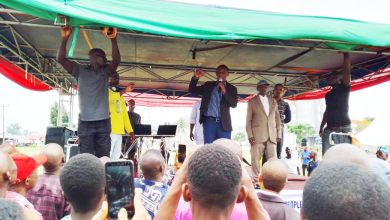STRENGTHENING LOCAL GOVERNMENT AUTONOMY IN NIGERIA: A Path to Grassroots Development and Accountability

Local Government Autnomy The ramifications of the dwindling autonomy of local governments in Nigeria are multifaceted and palpable. At present, local government areas across the nation grapple with political
interference, limited fiscal capacity, and a dearth of developmental initiatives.
Social Action has been at the forefront of a tireless campaign to lobby for the restoration of local government autonomy in Nigeria.
Our efforts have included advocacy, public awareness campaigns, and engagement with policymakers at various levels of government. While faced with numerous obstacles and resistance from vested
interests, Social Action has achieved intermittent successes in our
mission to restore local government autonomy.
During the 9th Assembly, the campaign was taken to the National Assembly with the collaboration of the National Association of Local Government Employees and other stakeholders. The right momentum was built up, and adequate lobbying was done at the state level where it was required to attain the consent of 2/3 (about 67%) of the states and the National Assembly to amend the law in favour of fiscal and administrative autonomy for the local governments. Before the end of the 9th Assembly, 18 states
representing 50% percent of the states had passed the bill, while the other 18 states either withheld consent or abstained from voting. We were upbeat about achieving the number, as discussion and negotiations were still ongoing with the relevant stakeholders.
Then the antagonists went to work. Some of the state governors, who are the biggest opposition to local
government autonomy, impressed upon their state assemblies to keep delaying the process until the tenure of the 9th Assembly lapsed.
Historical Context of Nigeria’s Local Government System:
The historical roots of Nigeria’s local government system can be traced back to the era of colonial
rule during the late 19th and early 20th centuries The British colonial administration, in its quest to
establish control over the diverse regions of Nigeria, adopted a policy known as “indirect rule.” This policy
aimed to govern Nigeria through existing indigenous authorities, thereby reducing the cost and complexity of direct colonial administration. The British colonial authorities established native authorities in various regions of Nigeria, appointing traditional rulers and chiefs as local administrators. These native authorities were tasked with maintaining law and order, collecting taxes, and implementing British policies at the local level, (Adeyemi, O. 2012).
The primary objective of the native authorities was to serve as intermediaries between the colonial
administration and the diverse ethnic groups and communities scattered across the Nigerian landscape.
This arrangement allowed the British to govern Nigeria indirectly while leveraging existing traditional
structures.
Post-Independence Impetus for Local Governments:
The impetus for the creation of local governments in Nigeria gained momentum in the post independence era, particularly during the early years following Nigeria’s attainment of independence from British colonial rule on October 1, 1960. With newfound sovereignty, Nigerian leaders recognized the need for efficient governance and effective service delivery at the grassroots level (Akindele, S. T., & Olaopa, O. R. 2002). In response to the demands for decentralization and local governance, Nigeria underwent a significant administrative reorganization in the 1970s. This period witnessed the formal establishment and recognition of local government authorities as the third tier of government in Nigeria. On October 1, 1976, Nigeria adopted a new constitution that delineated the powers and functions of local governments, consolidating their status as essential units of governance in
the country. This constitution also defined their responsibilities and financial autonomy (Elaigwu, J. I.,
& Galadima, H. 2010).
Functions of Local Governments
Local governments, as envisioned in the postindependence era and formalized in the 1976 constitution, were endowed with critical functions. These functions were designed to address the unique needs and aspirations of local communities and to foster a sense of ownership and participation among
citizens (Olowu, D., & Wunsch, J. S. 2004).
- Primary Healthcare Delivery: Local governments were tasked with the responsibility of providing
accessible and effective healthcare services to their constituents. This included the establishment
and management of local health clinics and the coordination of public health initiatives. - Primary Education Administration: Local governments were responsible for overseeing primary education within their jurisdictions. This encompassed the construction and maintenance of
primary schools, the employment of teachers, and the development of educational policies tailored to local needs. - Rural Infrastructure Development: A key mandate of local governments was the development of rural infrastructure, including roads, bridges, water supply systems, and electrification projects. These initiatives aimed to improve the living conditions of rural dwellers and facilitate economic activities.
- Grassroots Representation: Local governments were seen as the closest form of government to the
people. They were expected to provide a platform for citizens to voice their concerns, participate in
decision-making processes, and hold elected officials accountable. The establishment of local governments in Nigeria was thus driven by a vision of efficient governance, community development, and grassroots representation. These institutions were intended to serve as instruments for bridging the gap between the people and the centralized state apparatus, promoting the equitable distribution of resources, and fostering national development (Olowu, D., & Wunsch, J. S. 2004). However, the initial promise of local government autonomy and effectiveness gradually eroded over time, impacting their ability to fulfill their designated
functions effectively
- Grassroots Representation: Local governments were seen as the closest form of government to the
The Decline of Local Government Autonomy:
Over time, the noble vision of local government autonomy and effectiveness began to wane. One
significant factor contributing to this decline was the erosion of financial autonomy, a development
that significantly hindered local governments’ ability to fulfill their designated functions. The primary
culprits responsible for this erosion were state governments, which sought to centralize control over
local government finances for political and economic gain. This unwarranted intrusion resulted in severe
underfunding of local governments, rendering them dependent on state allocations and unable to execute projects or meet the needs of their constituencies effectively. One of the excuses brandied by the state governors was the inability of the local government councils to pay teachers’ salaries. The council
authorities were accused of gross corruption and the responsibility of attending to teachers’ salaries was
taken away from them. While this was largely the case, one of the factors that needed to be considered for this failure to meet up with the payment of the teachers’ salaries is the fact that the local governments were paying salaries for teachers that were employed by the state government. Besides, currently there are states that are owing months in arrears of teachers’ salaries.
This is a very sore point which even the National Union of Teachers has spoken in favour of the state
government to have control of the payment of teachers’ salaries. But beyond the payment of salaries, there are many other responsibilities that the local governments could assume under the atmosphere of autonomy to drive developments in the local governments.
Justification for the Campaign:
In the intricate tapestry of Nigeria’s political landscape, the three tiers of government—the
federal, state, and local—constitute the fundamental building blocks of governance, each with its distinct
roles and responsibilities. Among these, the local government, frequently acknowledged as the third
tier of government, holds a pivotal position in the nation’s quest for effective governance and sustainable
development.
The justification for the return of autonomy to local governments is clear and compelling. It lies in the restoration of democratic principles, fostering grassroots development, and empowering local communities to chart their destinies. Autonomy would mean that local governments can access and
manage their resources independently, allocate funds judiciously, and initiate projects that align
with the needs and aspirations of their constituents. With this in place, it would become easier to hold
the local government authorities to account for the management of the resources, so far as they are in full and direct control of the resources allocated to them The local government is the linchpin that brings
governance and development to the grassroots level, serving as a bridge between the federal and state
governments and the ordinary citizens. It plays a multifaceted role by not only implementing policies
and programs designed by higher tiers but also tailoring them to suit the specific needs and aspirations
of local communities. This decentralization of power and decision-making ensures that the benefits of
democracy and development are more accessible and responsive to the diverse needs of Nigeria’s vast
and culturally rich population. In essence, the local government serves as the bedrock of participatory
democracy, fostering community engagement and socio-economic progress across the nation.
Looking Beyond Autonomy:
While autonomy is a crucial step toward good governance at the local level, it is not a panacea. Transparency and accountability must be actively cultivated and enforced to prevent resource abuse
and corruption by local government authorities.
Measures such as robust auditing, citizen oversight, and capacity-building programs for local officials are
essential. The budgets and fiscal documents of the local governments must not only be made available
but also proactively available to any citizen who demands for them. Projects must emanate from the
people through NEEDs assessment and the conduct of town hall meetings to harvest inputs for the budget.
Procurements must be done through an open bidding system and transparent selection methods to ensure fairness and transparency. Envisaged malfeasances at the local government level,
even after autonomy, could include embezzlement of funds, nepotism in project allocation, and neglect
of marginalized communities. To combat these challenges, a vigilant civil society must remain
engaged, monitoring the actions of local governments and advocating for the interests of their constituents.
The conduct of election into local government positions should not be vested on the state electoral
commissions where the governor not only appoint the heads of the Commission but also employs the staff and also fund the exercise. The evidence of a gross manipulations of local government election is seen in the composition of membership of the winners of such elections into the council. They all belong to the ruling party in the state and are stooges of the governor of such state. Therefore, even if autonomy is attained on the long run, the governor could still place their puppets in the positions at the local councils and get them to sign off funds meant for the development of the communities to the state governors.
Strategies for Sustaining Momentum:
To ensure that the momentum toward local government autonomy and accountability endures,
civil society organizations like must continue their advocacy efforts, engage in capacity building for local
leaders, and leverage technology for transparency and citizen engagement. Public awareness campaigns,
community mobilization, and collaboration with international partners can help sustain the pressure
for reform.
The restoration of local government autonomy in Nigeria is not merely a matter of administrative
decentralization but a fundamental step towards realizing the ideals of democracy, development, and
accountability. Achieving this goal requires collective action, unwavering commitment, and a vision for a
future where local governments can truly serve as instruments of positive change at the grassroots level.
Conclusion:
The journey to strengthen local government autonomy in Nigeria has been marked by historical significance and contemporary challenges. The local government system, as the third tier of governance, holds the key to grassroots development, participatory democracy, and effective service delivery. However, over time, the erosion of financial autonomy has hindered local governments’ ability to fulfill their vital functions.
Social Action, alongside other civil society organizations, has played a pivotal role in advocating
for the restoration of local government autonomy.
Despite facing resistance, there have been significant strides, including legislative progress in some states.
However, the road ahead remains challenging, with vested interests opposing change.
The Way Forward/Recommendations:
To achieve local government autonomy, a multifaceted approach is essential. This includes legal reforms,
public engagement, and political will. Stakeholders such as civil society organizations, community
leaders, and concerned citizens should continue to press for reforms that guarantee financial autonomy
and strengthen the capacity of local governments to govern effectively. This might require funds, sacrifices, more collaborations and lobbying with policy makers.
The bill needs to be represented to the National Assembly for fresh deliberation and following the
process all over again and believing to be able to get 2/3rd of the National and States Assemblies to give
their nods.
Another, alternative way is to ensure that the state government are closely monitored and made to
account for the funds collected on behalf of the local government. Reports have it that over N15 trillion have been allocated to the 774 local governments in Nigeria between 2007 and 2018 (Olufemi, 2019), without any significant development in the local communities.
The noticeable infrastructural growths are mainly in the capital cities and urban centres, thus the bulk of
the funds were either misapplied or misappropriated by the state governors. It is therefore expected that
when the expenditure is closely followed and the state governors made to account for the funds, the
attraction for managing the resources meant for the local government will reduce. This may force the state governors to pay less political attention to the control of the local government resources which would, in turn, be a gain for the campaign for autonomy.
The following is, therefore, recommended
- Legal Reforms: There is an urgent need for comprehensive legal reforms to safeguard local government autonomy. Legislation should define and protect their financial independence, responsibilities, and authority.
- Transparency and Accountability: Local governments should prioritize transparency in
financial management. Publish budgets, expenditures, and procurement processes to ensure accountability. Citizens should have easy access to these documents upon request. - Civil Society Engagement: Civil society organizations must continue their advocacy efforts,
raising awareness about the importance of local government autonomy. Engage with communities to mobilize support and build a groundswell for change. - Electoral Reforms: Local government elections should be independent of state governments to
ensure fairness and genuine representation. Electoral processes should be transparent and free from
manipulation. - Monitoring State Governments: Vigilant oversight of state government handling of local government fundsis essential. This can help prevent misappropriation and reduce political interference.
- Capacity Building: Local government officials should receive training to enhance their capacity to
govern effectively. This includes financial management, project implementation, and citizen engagement. - Use of Technology: Leverage technology to improve transparency and citizen engagement. Online
platforms can be used to disseminate information, gather citizen feedback, and monitor local government activities. - Sustaining Momentum: Maintain pressure for reform through continuous advocacy, community
mobilization, and collaboration with international partners. A united front is crucial for long-term
success.
The restoration of local government autonomy in Nigeria is not just about administrative decentralization; it is a fundamental step towards realizing the ideals of democracy, development, and accountability. It requires collective action, unwavering commitment, and a vision for a future where local governments can truly serve as instruments of positive change at the
grassroots level.
This report was released and first published by Social Action, September, 2023.




